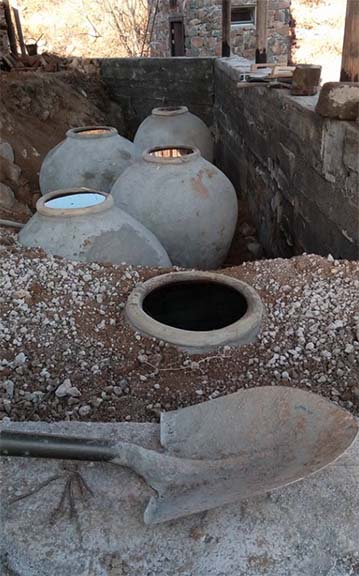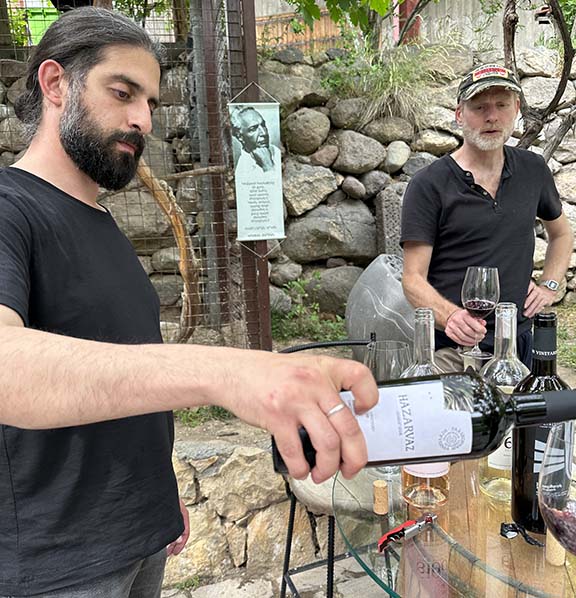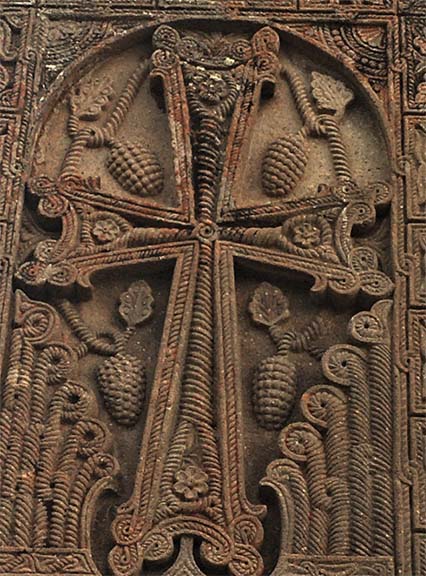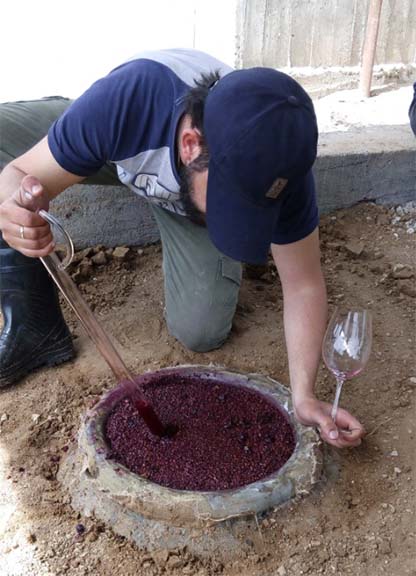Nestled in the heart of the picturesque Vayots Dzor region of Armenia, Trinity Canyon Vineyards stands as a testament to the rich winemaking heritage of this ancient land. With a history dating back centuries and a commitment to preserving traditional winemaking methods, Trinity Canyon Vineyards has emerged as a true gem in the world of viticulture and enology.
The Vayots Dzor region, situated in the southeastern part of Armenia, is renowned for its favorable climate, where the high-altitude vineyards and volcanic soil create the ideal conditions for grape cultivation. This region's history is intertwined with winemaking, and Trinity Canyon Vineyards embodies the spirit of tradition and innovation.
Trinity Canyon Vineyards takes its name from the biblical symbol of the Holy Trinity, representing the Father, Son, and Holy Spirit, which is of great significance in Armenia, a country known for its deep-rooted Christian traditions. The winery's commitment to quality is reminiscent of this divine trinity, with a harmonious blend of nature, tradition, and modern techniques.
The winery's vineyards sprawl across the rugged terrain of Vayots Dzor, where indigenous Armenian grape varieties such as Areni and Voskehat thrive. These grapes are carefully nurtured, handpicked, and processed with utmost care to create exceptional wines. Trinity places a strong emphasis on sustainable viticulture, respecting the land and environment that give life to their wines.
One of Trinity Canyon Vineyards' standout products is its Areni wine. The Areni grape, an ancient indigenous variety, is believed to be one of the oldest grape varieties still in existence, with a history that spans over 6,000 years. Trinity Canyon Vineyards' master winemakers skillfully transform this grape into wines that beautifully capture the essence of the Vayots Dzor region. The deep ruby color, complex aromas, and robust flavors make Areni wine a true reflection of the terroir.
In addition to preserving traditions, Trinity Winery also embraces modern winemaking techniques. The state-of-the-art facilities house temperature-controlled fermentation tanks, oak barrels for aging, and a team of expert oenologists who bring innovation and precision to the winemaking process. This blend of tradition and modernity results in wines that honor the past while catering to the tastes of today's discerning wine connoisseurs. Grape Collective talks with Artem Parseghyan, winemaker at Trinity Canyon Vineyards about the evolution of wine in Armenia and the importance wine holds in Armenian culture.
 Grape Collective: Tell us a little bit about Trinity and how it came into existence.
Grape Collective: Tell us a little bit about Trinity and how it came into existence.
Artem Parseghyan: So the history of Trinity started back in 2009 when we started to plant the vineyards. We are currently in the region of Vayots Dzor in the Aghavnadzor village, which is one of the most important regions in terms of the quality of autochthonous wines. in 2009, we started to plant the vineyards. Then we made our first commercial vintage in 2013. It was a really tiny production, just 5,000 bottles. And, we didn't have a winery at that time. We were making wine at some French places, some other incubator wineries.
In 2016, we realized that this scheme is not really working because we're greedy Armenians and so we're trying to expand our production volumes. So we built our first garage winery and the plantings actually continued until last year. And currently we're working with about 11 hectares of vineyards, producing 55,000 bottles.
So it was kind of a big jump for us, even though we're not producing big volumes of wine nowadays, but from 5,000 to 55,000 was quite the jump as we also expanded the production lines. We work currently with seven different varieties, three autochthonous varieties, and also doing some small batch experiments with international varieties, using them in blends in different cuvees.
We were also one of the first companies to start applying organic agricultural principles. We were the first company to get the full range certification, international recognized certification, for organic agriculture and organic processing. However, a couple of years ago, we dropped this process and we refused to be certified anymore.
We keep doing everything in the same way because this is our philosophy, not the marketing for us. So we don't have the green logo type on the label, but we still do everything the same way.
Do you feel that Armenia as a wine community is moving in the direction of organics?
Well, I think, in Armenia you know, the movement for organic agriculture is done in two separate ways. So for some people it's still dominantly a marketing tool, but we're very happy to see a lot of new small or medium sized projects that think about organic agriculture as a way of thinking and as a philosophy, which was the case for us as well.
So, we started to do everything organically, just because we think that treating the soil in a certain way and treating our wines in a certain way, is the only way to go forward. We don't think about organic as the only way possible to produce quality wines, but we think about it as the best.
 And talk a little bit about the fact that you have very interesting origin stories in Armenia.
And talk a little bit about the fact that you have very interesting origin stories in Armenia.
You have this very interesting history of winemaking that's very old. So it's true to say that Armenia is neither a new wine world nor an old wine world, because we had about 80 years during the Soviet period when basically the winemaking traditions were either lost or nearly abandoned, lowering the quality of the wines produced.
But at the same time, Armenia is kind of a historical world of wine because wine was produced here for millennia, even before Armenians were living in this place. We realized that 6,100 years ago, which is, by the way, the age of the Areni-1 cave, there were no Armenians here. So this is on one hand, the support for our producers to know our origins.
I see in many cases that this also is becoming kind of a restrictive factor. So people are not looking forward towards new technologies, new planting, principles, agricultural principles, winemaking principles, talking and thinking only about the history, about the traditions, ancient background and so on. So I believe that the good way for Armenian winemaking to develop is to realize both. To understand and recognize that we are a very old wine producing country. But also think about the fact that we have been out of the market for too long and we need to rediscover, reinvent, kind of understand again what we're capable of, what our varieties are capable of, what our soil is capable of.
The Soviets had a somewhat negative impact, in terms of forcing Armenia to become primarily a brandy producer. Do you have any thoughts about what life was like back then or what happened to the country in terms of its wine traditions under Soviet rule?
So Armenia was producing wine for millennia and we had different periods of break, but every time we were able to make wine again, we were doing that. So it was before Christianity, it was during Christianity, it was during some parts of the Ottoman Empire invasion. Turks, Persians, whoever came, they were trying kind of to restrict everything that was around wine and restricting wine.
But the Soviet time, which was probably the last point when we were forced not to produce wine because of the planned economy and this decision by the government that Armenia is one of the brandy producing countries, while the others Soviet countries might produce wine as well.
So Armenia, every time that we were able to produce wine, we started it over again. The Soviet period also created a separation between the disciplines. So even like in the education system, the disciplines of viticulture and winemaking were separated. So we ended up having a lot of specialists who knew how to grow grapes, but they never understood why they were growing the grapes.
And on the other hand, we had winemakers, technologists, that knew how to make wine, but they didn't really realize what was the origin of the wine and this absence of link between the two disciplines created a drawback of quality. So, we believe truly that the quality of the wine starts from the grapes, and you have to be, even if you are a genius, you are not able to produce a good wine from bad grapes and this is actually what we, the wine sector of Armenia, is trying to reconnect.
So connecting the vineyards, the soil with the quality of the wine. Of course the Soviet period didn't create only bad things in the country. We had the the cognac making, which is also very interesting, brandy making, which is also an interesting field and part of the wine culture and industry. So we are kindly currently trying to preserve both and develop both lines of production simultaneously.
Talk about the really interesting indigenous varieties that you have here.
They literally go back a very long time and they're very specific to the soil. That's why Armenia was known for more than 100 different cultivars of vitis vinifera.
Of course, during the historical events, we had some breaks and a lot of varieties unfortunately disappeared, or they are nearly extinct. Currently we have, I think, if I'm not mistaken, about 30 or 40 different grape varieties that are actively used in the winemaking in different regions of the country. In Vayots Dzor we have mostly a red variety, which is called Areni. And it's kind of a brand variety of the country. Armenian winemakers from all around Armenia are using this variety to make their wines. But it's mostly coming from the region of Vayots Dzor. In Vayots Dzor we don’t have a lot of white varieties and it's interesting that during the Soviet period, white varietals actually were preserved better because they were used for the brandy making.
And we can see currently that the plantations, the total plantations of the country, are predominantly red, but at the same time the white cultivars, in the number of cultivars, are more dominant because they were preserved. It is true Armenia has a very distinctive terroir and even being in a very small landlocked country because Armenia has been named one of the top 34 biodiversity hot spots all over the world, and the same thing applies also to the grape varieties.
So even inside of one village, we have so many different micro-terroirs that greatly affect the quality and the stylistics of the wines that are made. We work with three varieties, with three local varieties. That's two whites. That's Voskehat and Khatun Kharji, which we believe are very prominent. And we dominantly work with Areni or Areni Noir, in different cuvees and blends.
 Let's talk a little bit about Armenia being one of the top 34 hot spots for biodiversity.
Let's talk a little bit about Armenia being one of the top 34 hot spots for biodiversity.
So, there are several hot spots all around the world for biodiversity, so the diversity of fauna and flora, and Armenia is one of the 34 top biodiversity hot spots. One of the reasons is the geography, because we have so many different landscapes, different altitudes, altitudes that will create natural separation of populations.
And even in the region we have high biodiversity for plants and for fauna. The same thing also applies to the grape varieties that we have because they were grown here, if it is vinifera was domesticated here for millennia and naturally a lot of selective cultivars appeared during this cultivation and domestication process, which gives us a vast ability to work with different styles, different varieties and approaches in the winemaking.
Talk a little bit about the place that wine has in the culture of Armenia.
Wine as a part of culture has been with Armenians for millennia. So regardless of the religion that we're in, we're either Christians or even before Christianity wine was always the central part of our culture and we can see that also in old sculptures, old bas-relief and so on.
The grapevine was seen as the plant of life. So even like the most famous Armenian toast is ‘kenadz’ and this can mean ‘for life’ just like the Jews saying 'l’Chaim.' So even when we toast each other with a glass of wine in our hands, we say ‘for life’. The grapevine was actually seen as the tree of life, which was the second tree, back in the bible in the time of Adam and Eve.
So, with the tree of knowledge, with the time when different cultures were coming and going around, they were always trying to kind of restrict the growing of the grapevine or the production of wine. Because for some cultures, it was prohibited. But every time Armenians were historically able to produce wine again, we were doing that with great pleasure because we cannot live without wine. And I think people can see that when they talk with Armenians.
What are your hopes for the future of wine in Armenia?
The future of Armenian winemaking from my perspective is for sure to go towards quality, not quantity. Because we see in many New World countries, it was the reverse situation, that I think we are not allowed to repeat.
 So going after the quantities, being a bulk producing country, because Armenia is known in the world at some point as an ancient country. So we cannot produce bulk and regular decent styles of wine. We go towards premium and I'm really happy to see that the sector is developing exactly in that direction. So we don't produce much. But even like the big industrial wineries, they have at least a few labels that are outstanding in the quality level, a level that they can compete with international wines.
So going after the quantities, being a bulk producing country, because Armenia is known in the world at some point as an ancient country. So we cannot produce bulk and regular decent styles of wine. We go towards premium and I'm really happy to see that the sector is developing exactly in that direction. So we don't produce much. But even like the big industrial wineries, they have at least a few labels that are outstanding in the quality level, a level that they can compete with international wines.
(Photo: A new addition to Trinity's collection of the Armenian medieval cross stone images with grape ornaments from Tsakhats Kar monastery, Vayots Dzor.)
Another advantage that we have, together with other small countries that are new to the wine world is the ability to present to our international consumer the vast amount of local autochthonous varieties that are really interesting. So people everywhere are too tired to drink, you know, Cabernet Sauvignon, Shiraz, Chardonnay and Merlot. And it's a good opportunity for us to present them our varieties with their own unique, style and profiles.
And talk about the terroir in Vayots Dzor and why it's such an important region in Armenia.
We're currently in Vayots Dzor province, which is in the southeast of the country. We are in a high elevation place. So our vineyards here are starting from 1,000 meters above sea level and going up to 1,800 meters, which is one of the highest vineyards in the whole northern hemisphere. We have a very unique volcanic soil, which is similar to only a few places in the world.
The high amount of mountains also creates diversity in the soil profile. So when we say volcanic, it's not just one type of volcanic soil, but some parts are more with limestone, the other parts are with clay. This also creates a very unique opportunity to produce different styles of wine combined with the local varieties such as Areni that is really able to express the character of the soil.
We have an endless number of possible outcomes from the winemaking point of view to produce different styles of wine.
Can we talk a little bit about how you make wine, about your experiments?
We started in 2009 by planting the vineyards. We started with local varieties only, and this was our main focus. And the idea behind the wine project was just to produce enough volume of wine to provide the restaurants that the founders of the company also own in Yerevan and then grow it into a business.
Currently we work with 11 hectares of vineyards. We're the first to introduce international varieties to Vayots Dzor. Some people say it's not really good, but for us it was not the focus of production, it was just the way to understand our soil and our terroir, which is unknown with these varieties.
We know what to expect from Syrah. It was interesting to understand what is the potential of the soil, working with the known variety and actually the knowledge that we gathered from these experiments with international varieties. We kind of extrapolated to our local varieties which are about 80% of our production now, local varieties. In the winery we believe in one concept, which is the low intervention winemaking.
 We try to put as little as possible into our own technological efforts and work mostly with the potential of the soil. For this reason, we have a lot of vinification during the vintage. So even if we produce just three or four Areni 100% labels, we do about 25 different vinifications coming from different plots, different parcels, different soil types, and we kind of vinify the soil.
We try to put as little as possible into our own technological efforts and work mostly with the potential of the soil. For this reason, we have a lot of vinification during the vintage. So even if we produce just three or four Areni 100% labels, we do about 25 different vinifications coming from different plots, different parcels, different soil types, and we kind of vinify the soil.
Our wines are a blend of different terroirs. That's the only way, in our opinion, to get experience, because what is experience in winemaking? Twenty years of wine experience, that's 20 times you were able to make wine. So every time we try to get as much as possible, from the vintage, from ourselves, from our grapes.
You use karas, the traditional amphora.
In 2016, we also decided to work with our traditional vessels, clay vessels, which are called karas. These are amphora that were made here for as long as wine was made. And we even named our line of production ‘Ancestors’. So Voskehat Ancestors, which is made in the orange style, and Areni Ancestors, which is a red Areni, are made in the karas.
This is a separate line of production. So if all other wines are organic, they are made with organic principles, but in classical European style, stainless steel bariques and so on. Here with the natural wines, we have a little bit of a different approach. So we use amphora for vinification for a very long maceration and the wines that come out of from the karas are unfiltered and fined without sulfur, so really natural, funky stuff.
We like it. It's a really small volume because it's hard to get the karases as the traditions of karas making were unfortunately lost during the Soviet period. Again, but we tried to find old amphoras all around the country in the villages, just buying them, restoring them as much as we can and using them for our natural wine project.
In Armenia, the traditional winemaking that was done in this kind of clay amphoras as much as we know from history was done in two different types of amphora. So there they were, karases that were above the ground and they were used exclusively for the fermentation and vinification, the aging of the wine material, either with the skins. So the must or the pure wine already was done in the amphora that were buried either completely or in most of the cases, two thirds to a third of the karas was buried. The other one third was above the ground. The main reason was to control the temperature and to have a more controlled process of aging and maceration. In our case, this is very important, especially because we don't just age the wine in karas. But we do a six months maceration so our wine stays with the skins in amphora which is completely sealed, for six months. And it is very important for us to have as much as possible better temperature control. So far the, the outcome of the experiments we like, we hope to have better results in the future.










